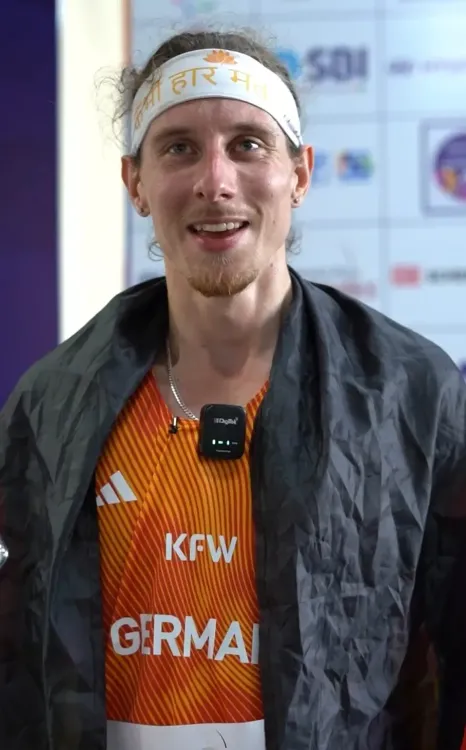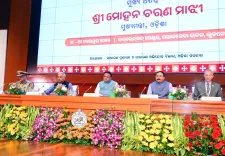How is German Para Athlete Maximilian Honoring India with His Unique Headband?

Synopsis
Key Takeaways
- Maximilian's victory at the championships highlights the intersection of sports and culture.
- The headband's message serves as a powerful reminder to athletes about resilience.
- Expressions of gratitude can strengthen bonds between nations.
- Acts of respect, like wearing local language phrases, enhance cultural appreciation.
- Maximilian's journey showcases the importance of mental strength in overcoming challenges.
New Delhi, Oct 5 (NationPress) During the prestigious World Para Athletics Championships taking place at Jawaharlal Nehru Stadium, the remarkable German sprinter Max Maximilian celebrated his victory by embracing India’s rich culture. The athlete clinched the gold medal in the men’s 400m T47 event and expressed his gratitude through a symbolic gesture.
In his final race, Maximilian donned a white headband adorned with saffron-colored Hindi letters that read Kabhi Haar Mat Mano (Never Give Up). The headband also showcased a lotus flower, representing purity and resilience, which he connects with his own Buddhist beliefs.
This was not merely a good luck charm for Maximilian; it was a heartfelt tribute to India. After overcoming competitors such as Japan’s Ryota Fukunaga and Botswana’s Bose Mokgwathi, he remarked, “As athletes, we are welcomed here with incredible warmth. Wearing Hindi words on my forehead was my way of honoring this beautiful country. We aim to express our gratitude towards our hosts wherever we compete.”
The inspiration for this meaningful gesture came from his coach, Steffi Nerius, an Olympic javelin medalist, who had a tradition of sporting phrases in the language of the host country as a mark of respect. Maximilian adopted this custom in Delhi, making it uniquely his own.
The inclusion of the lotus symbol deepened the significance of the headband. For the 29-year-old, it epitomized resilience and grace—attributes that reflect his journey through injury recovery.
“In Buddhism, grace and resilience hold great importance. It signifies moving forward despite challenges. For me, this symbol was perfect,” he explained.
This wasn’t merely a display; the message on his headband fueled his determination during the race. In the climactic moments, with Fukunaga in the lead, Maximilian found himself on the verge of losing gold. However, the words on his forehead reignited his resolve. He pushed himself to the limit and triumphed by a mere three hundredths of a second.
Post-race, he shared, “I was battling knee pain and unable to train effectively for weeks. This medal was completely unexpected. However, the headband's message reminded me—never give up.”
Maximilian’s headband became a focal point of discussion after the race. He conveyed a mix of joy and emotion, as the moment transcended the medal—it represented the bond an athlete forms with a culture that has shown them kindness and hospitality.
In conclusion, he stated, “In sports, respect is as crucial as performance. Tonight, my aim was to express that respect to India. I am grateful that India awarded me a gold medal during tough times.”









